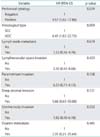1. Takeshima N, Katase K, Hirai Y, Yamawaki T, Yamauchi K, Hasumi K. Prognostic value of peritoneal cytology in patients with carcinoma of the uterine cervix. Gynecol Oncol. 1997; 64:136–140.
2. Kasamatsu T, Onda T, Sasajima Y, Kato T, Ikeda S, Ishikawa M, et al. Prognostic significance of positive peritoneal cytology in adenocarcinoma of the uterine cervix. Gynecol Oncol. 2009; 115:488–492.
3. Estape R, Angioli R, Wagman F, Madrigal M, Janicek M, Ganjei-Azar P, et al. Significance of intraperitoneal cytology in patients undergoing radical hysterectomy. Gynecol Oncol. 1998; 68:169–171.
4. Delgado G, Bundy BN, Fowler WC Jr, Stehman FB, Sevin B, Creasman WT, et al. A prospective surgical pathological study of stage I squamous carcinoma of the cervix: a Gynecologic Oncology Group Study. Gynecol Oncol. 1989; 35:314–320.
5. Kilgore LC, Orr JW Jr, Hatch KD, Shingleton HM, Roberson J. Peritoneal cytology in patients with squamous cell carcinoma of the cervix. Gynecol Oncol. 1984; 19:24–29.
6. Imachi M, Tsukamoto N, Matsuyama T, Nakano H. Peritoneal cytology in patients with carcinoma of the uterine cervix. Gynecol Oncol. 1987; 26:202–207.
7. Kashimura M, Sugihara K, Toki N, Matsuura Y, Kawagoe T, Kamura T, et al. The significance of peritoneal cytology in uterine cervix and endometrial cancer. Gynecol Oncol. 1997; 67:285–290.
8. Sedlis A, Bundy BN, Rotman MZ, Lentz SS, Muderspach LI, Zaino RJ. A randomized trial of pelvic radiation therapy versus no further therapy in selected patients with stage IB carcinoma of the cervix after radical hysterectomy and pelvic lymphadenectomy: a Gynecologic Oncology Group Study. Gynecol Oncol. 1999; 73:177–183.
9. Delgado G, Bundy BN, Fowler WC Jr, Stehman FB, Sevin B, Creasman WT, et al. A prospective surgical pathological study of stage I squamous carcinoma of the cervix: a Gynecologic Oncology Group Study. Gynecol Oncol. 1989; 35:314–320.
10. Morris PC, Haugen J, Anderson B, Buller R. The significance of peritoneal cytology in stage IB cervical cancer. Obstet Gynecol. 1992; 80:196–198.








 PDF
PDF ePub
ePub Citation
Citation Print
Print





 XML Download
XML Download